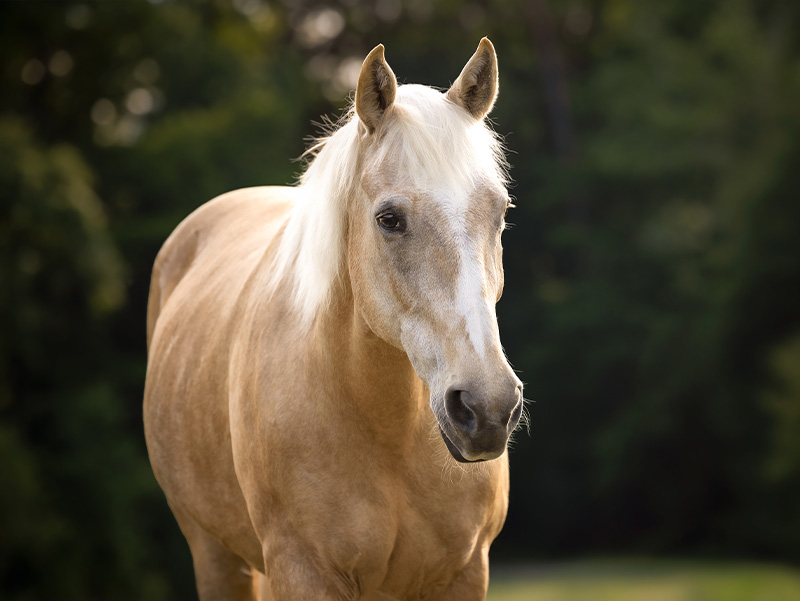Cushing's disease, also known as Pituitary Pars Intermedia Dysfunction (PPID), is an endocrine disorder that affects the production of hormones. This metabolic disorder primarily affects senior horses but certain breed such as Morgans and ponies may be predisposed. If not addressed, this condition can lead to serious health complications and even be fatal.
This article examines the underlying causes of Cushing's disease, the indicators and symptoms that horse owners should be aware of, and the various treatment approaches involving medications, nutrition, and exercise.
What is Cushing's Disease in Horses?
Cushing's disease is a common metabolic disorder that affects horses of all ages but is most commonly seen in older animals.
An overproduction of hormones caused by the pituitary gland, specifically the parts intermedia, leads to various symptoms affecting a horse's health and well-being.
The hormone overproduction in horses with PPID can disrupt their body's normal processes, resulting in the classic symptoms of weight loss, lethargy, and a long, coat that doesn't shed properly.
Other symptoms include increased thirst and urination, infection susceptibility, abnormal fat distribution, and laminitis. Horses with Cushing's disease also have a higher risk of developing other conditions, such as insulin resistance.
If left untreated, Cushing's disease can significantly impact their quality of life and potentially lead to life-threatening complications. Therefore, early diagnosis and proper management are essential to improve the horse's prognosis and quality of life. Veterinary consultation and a comprehensive treatment plan are crucial for treating PPID in horses.
Symptoms of Cushing's Disease
Has your horse been showing any unusual signs or symptoms lately? They might be experiencing Cushing's disease. Here are some signs and symptoms to look out for:
Signs of Cushing's Disease in Horses
Shaggy Coat
One of the most visible signs of Cushing's disease is a long, curly coat that doesn't shed properly, even in warm weather.
Fatty Deposits
Horses with PPID may develop fatty deposits in unusual places, such as the neck, shoulders, and tailhead crest.
Increased Urination and Thirst
Horses with this condition may urinate more frequently and have constant thirst.
Laminitis Weight Loss and Muscle Wasting
PPID can increase the risk of laminitis, a painful hoof condition leading to lameness.
Weight Loss and Muscle Wasting
Horses with Cushing's disease may lose weight, topline and muscle mass, leading to a pot-bellied appearance.
Decreased Appetite
Your horse may seem less interested in food and have a reduced appetite.
Lethargy
Your horse may seem less energetic than usual resulting in a change in attitude and performance.
Increased Susceptibility to Infections
Horses with Cushing's disease are more vulnerable to infections due to weakened immune function.
Diagnosing PPID in Horses
Diagnosis and testing for Equine Cushing's disease are crucial for proper management and treatment. Here are the methods used for diagnosing PPID:
Clinical Signs
Cushing's disease in horses can be identified by clinical signs such as a long, curly hair coat, potbelly, muscle wasting, laminitis, and increased thirst and urination. Veterinary evaluation and testing are required for a confirmed diagnosis.
Blood Tests
The ACTH stimulation test is the most common blood test for diagnosing Cushing's disease in horses. This test measures the cortisol levels in the horse's blood before and after injecting synthetic ACTH. It helps evaluate the horse's adrenal function and assess whether the pituitary gland overproduces ACTH.
Urine Tests
Cortisol and its breakdown products can be measured in the horse's urine. The urinary cortisol-creatinine ratio (UCCR) test is a simple and non-invasive test that can help confirm the diagnosis.
Imaging
Radiographs or ultrasounds may be used to evaluate the horse's internal organs and detect abnormalities in the pituitary gland.
TRH Stimulation Test
In some cases, a TRH stimulation test may be used with the ACTH stimulation test to help confirm a diagnosis of PPID. TRH stimulates the release of TSH from the pituitary gland, which, in turn, stimulates the thyroid gland.
Equine Cushing's Disease - Treatment & Preventative Care
Treatment options for Cushing's disease in horses vary depending on the severity of the condition and the horse's individual needs. Treatment aims to manage the symptoms and improve the horse's overall quality of life.
Diet & Exercise
It is always important to consult with a veterinarian or equine nutritionist to come up with an appropriate feed plan based on horse’s age, weight and underlying health conditions.
Horses with metabolic conditions such as PPID or Insulin Resistance should be on low non-structural carbohydrate (NSC) diets to help reduce starches/sugar, which in turn will help keep glucose levels down.
It is important to provide free choice hay 24/7 when possible. If forage is restricted, your horse perceives this as ‘survival mode’ – they will hold on to body fat and store as it is uncertain as to when the next food will be available. Once they learn that they will always have access to hay and not run out they will learn to self-regulate. They will eat more slowly and less – only eating what the body needs. Insulin sensitivity increases and body weight begins to normalize. With the help of exercise, your horse’s cells will respond to insulin better and no longer store excess body fat. Pasture grazing should be monitored during certain times of the year when sugar content is high (Spring/Fall).
Exercise regiments should be tailored to the individual horse and gradually introduced, keeping feed program in mind and adjust as necessary based on level of activity. A well balanced diet and proper exercise routine will help promote overall health and can help reduce the risk of Laminitis often associated with PPID.
Ingredients such as magnesium and chromium can help support healthy blood sugar levels and when combined are thought to help with insulin sensitivity. Antioxidants like vitamin E and C help to combat oxidative stress.
Medication
The prescription medication pergolide is suggested for use in horses who have history or clinical signs of PPID where testing has occurred to indicate ACTH blood levels are above normal range.The brand Prascend® is the first and only FDA-approved treatment for the control of the clinical signs of PPID, improving the horse’s quality of life but not necessarily extending their lifespan.
The primary objective of these medications is to reduce the production of hormones, particularly ACTH and cortisol. By effectively decreasing the secretion of ACTH and lowering cortisol levels with medication, it becomes possible to gain better control over the clinical symptoms associated with Cushing's disease. In most cases, medications are necessary throughout the horse's lifetime to maintain cortisol levels within the desired range.
Apart from managing cortisol levels, veterinarians may also prescribe medications to address insulin resistance, which is commonly associated with Cushing's disease in horses.
Hoof Care
Horses with PPID may be prone to laminitis, a painful condition that affects the hooves. Regular hoof care, including frequent trimming and monitoring for signs of laminitis, can help support a healthy hoof and help manage this condition. Ingredients such as Biotin can be helpful in supporting a strong, healthy hoof.
Additionally, routine dental check-ups and care play a crucial role in supporting horses with Cushing's disease. Due to the disorder, these horses are more prone to developing issues such as excessive plaque accumulation, tartar, and gum disease. Consistent dental care, similar to hooves, can help prevent these problems and promote a healthy mouth for your horse.
Deworming
Deworming is an essential practice for all horses, but it holds particular significance for horses affected by Cushing's disease. Horses with this condition often experience a weakened immune system, making them more susceptible to parasite infections.
As a result, these horses have a higher likelihood of contracting parasites, and the infections they develop can be more severe. It is crucial to establish and maintain a consistent deworming schedule for your horse to minimize the risk of worm infestations and related infections.
Conclusion
Through proper wellness care and diligent management, horses with Cushing's disease can experience an enhanced quality of life.


